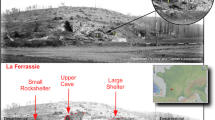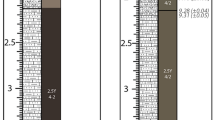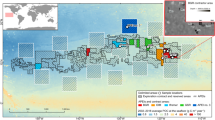Abstract
The Lower Cambrian (lower Toyonian) Tianheban Formation of Hubei Province, South China, includes small archaeocyath–calcimicrobial reefs that formed by combinations of archaeocyaths (e.g., Archaeocyathus yichangensis) and calcimicrobes (including Epiphyton, Renalcis, and Girvanella). The archaeocyaths provided substrates onto which the calcimicrobes became attached. In particular, Girvanella encrusts directly upon the surfaces of archaeocyaths, and bush-shaped aggregations of Epiphyton, growing downward, spread over the Girvanella. The remaining spaces among these reef framework-builders are infilled by chambered forms of Epiphyton and/or Renalcis. These calcimicrobes made a strong contribution to reinforcement of the reef frameworks. The archaeocyath-bearing reefs in South China first appeared during the Atdabanian and are last seen in the early Toyonian Tianheban Formation in Hubei Province. Subsequent reefs are purely microbial reefs without archaeocyaths. The Tianheban reefs are therefore the last representatives of archaeocyath-bearing reefs in South China. These reefs, reported herein, record the transition from archaeocyath–calcimicrobial reefs to purely microbial reefs during the Toyonian. Further studies involving integrated geobiological and geochemical analyses are needed to identify the factors that led to the demise of archaeocyath-bearing reefs and that subsequently hindered the development of skeletal-dominated reefs for 40 million years.











Similar content being viewed by others
References
Adachi N, Ezaki Y, Liu J (2011) Early Ordovician shift in reef construction from microbial to metazoan reefs. Palaios 26:106–114
Álvaro JJ, Debrenne F (2010) The Great Atlasian Reef complex: an early Cambrian subtropical fringing belt that bordered West Gondwana. Palaeogeogr Palaeoclimatol Palaeoecol 294:120–132
Álvaro JJ, Vennin E (1998) Stratigraphic signature of a terminal Early Cambrian regressive event in the Iberian. Can J Earth Sci 35:402–411
Álvaro JJ, Vennin E, Moreno-Eiris E, Perejón A, Bechstädt T (2000) Sedimentary patterns across the Lower–Middle Cambrian transition in the Esla nappe (Cantabrian Mountains, northern Spain). Sediment Geol 137:43–61
Álvaro JJ, Monceret E, Monceret S, Verraes G, Vizcaïno D (2010) Stratigraphic record and palaeogeographic context of the Cambrian Epoch 2 subtropical carbonate platforms and their basinal counterparts in SW Europe, West Gondwana. Bull Geosci 85:573–584
Barnaby RJ, Read JF (1990) Carbonate ramp to rimmed shelf evolution: Lower to Middle Cambrian continental margin, Virginia Appalachians. Geol Soc Am Bull 102:391–404
Brasier MD (1995) The basal Cambrian transition and Cambrian bio-events (from Terminal Proterozoic extinctions to Cambrian biomeres). In: Walliser OH (ed) Global events and event stratigraphy in the Phanerozoic. Springer, Berlin, pp 113–118
Dang H, Liu J, Yuan X (2008) Microbialites in the Middle Cambrian Qinjiamiao Group in Xingshan, Hubei Province: implication for paleoenvironmental reconstruction. Acta Sci Nat Univ Pekinensis 2008(2):40–47 (In Chinese with English abstract)
Debrenne F, James NP (1981) Reef-associated archaeocyathans from the Lower Cambrian of Labrador and Newfoundland. Palaeontology 24:343–378
Debrenne F, Kruse PD (1986) Shackleton limestone archaeocyaths. Alcheringa 10:235–278
Debrenne F, Rozanov A, Webers GF (1984) Upper Cambrian Archaeocyatha from Antarctica. Geol Mag 121:291–299
Debrenne F, Gandin A, Zhuravlev AY (1991) Palaeoecological and sedimentological remarks on some Lower Cambrian sediments of the Yangtze platform (China). Bull Geol Soc France 162:575–583
Debrenne F, Zhuravlev AY, Kruse PD (2002) Class Archaeocyatha Bornemann, 1884. In: Hooper NA, Van Soest RMW (eds) Systema Porifera: a guide to the classification of sponges. Kluwer Academic/Plenum Publishers, New York, pp 1539–1699
Elicki O (1999) Palaeoecological significance of calcimicrobial communities during ramp evolution: an example from the Lower Cambrian of Germany. Facies 41:27–40
Fagerstrom JA (1991) Reef-building guilds and a checklist for determining guild membership: a new approach for study of communities. Coral Reefs 10:47–52
Gandin A, Debrenne F (2010) Distribution of the archaeocyath–calcimicrobial bioconstructions on the Early Cambrian shelves. Palaeoworld 19:222–241
Glass LM, Phillips D (2006) The Kalkarindji continental flood basalt province: a new Cambrian large igneous province in Australia with possible link to faunal extinction. Geology 34:461–464
Grasby SE, Sanai G, Beauchamp B (2011) Catastrophic dispersion of coal fly ash into oceans during the latest Permian extinction. Nature Geosci 4:104–107
Grotzinger J, Adams EW, Schröder S (2005) Microbial-metazoan reefs of the terminal Proterozoic Nama Group (c. 550–543 Ma), Namibia. Geol Mag 142:499–517
Hicks M, Rowland SM (2009) Early Cambrian microbial reefs, archaeocyathan inter-reef communities, and associated facies of the Yangtze Platform. Palaeogeogr Palaeoclimatol Palaeoecol 281:137–153
Hough ML, Shields GA, Evins LZ, Strauss H, Henderson RA, Mackenzie S (2006) A major sulphur isotope event at c. 510 Ma: a possible anoxia–extinction–volcanism connection during the Early–Middle Cambrian transition? Terra Nova 18:257–263
James NP, Debrenne F (1980) Lower Cambrian bioherms: pioneer reefs of the Phanerozoic. Acta Palaeont Polon 25:3–4
James NP, Gravestock ID (1990) Lower Cambrian shelf and shelf margin buildups, Flinders Ranges, South Australia. Sedimentology 37:455–480
James NP, Kobluk DR (1978) Lower Cambrian patch reefs and associated sediments: southern Labrador, Canada. Sedimentology 25:1–35
James NP, Kobluk DR, Klappa CF (1989) Early Cambrian patch reefs, Southern Labrador. In: Geldsetzer HHJ, James NP, Tebbutt GE (eds) Reefs, Canada and adjacent areas. Can Soc Petrol Geol Mem 13:141–150
Knoll AH, Fischer WW (2011) Skeletons and ocean chemistry: the long view. In: Gattuso JP, Hansson L (eds) Ocean acidification. Oxford University Press, Oxford, pp 67–82
Kruse PD (1991) Cyanobacterial-archaeocyathan–radiocyathan bioherms in the Wirrealpa Limestone of South Australia. Can J Earth Sci 28:601–615
Kruse PD, Zhuravlev AY, James NP (1995) Primordial metazoan-calcimicrobial reefs: Tommotian (Early Cambrian) of the Siberian Platform. Palaios 10:291–321
Lehrmann DJ, Minzoni M, Li X, Yu M, Payne JL, Kelley BM, Schaal EK, Enos P (2012) Lower Triassic oolites of the Nanpanjiang Basin, south China: facies architecture, giant ooids, and diagenesis—implications for hydrocarbon reservoirs. Am Assoc Petrol Geol Bull 96:1389–1414
Li G, Steiner M, Zhu X, Yang A, Wang H, Bernd D, Erdtmann BD (2007) Early Cambrian metazoan fossil record of South China: generic diversity and radiation patterns. Palaeogeogr Palaeoclimatol Palaeoecol 254:229–249
Li F, Yan J, Algeo T, Wu X (2013) Paleoceanographic conditions following the end-Permian mass extinction recorded by giant ooids (Moyang, South China). Global Planet Change 105:102–120
Ogg JG, Ogg G, Gradstein FM (2008) Geologic time scale. Cambridge University Press, Cambridge
Peng S, Zhu X, Zuo J, Lin H, Chen Y, Wang L (2011) Recently ratified and proposed Cambrian Global Standard Stratotype-Section and Point. Acta Geol Sin (English Edition) 85:296–308
Pratt BR (1984) Epiphyton and Renalcis; diagenetic microfossils from calcification of coccoid blue–green algae. J Sediment Res 54:948–971
Pratt BR (1989) Deep-water Girvanella-Epiphyton reef on a Mid-Cambrian continental slope. Rockslide Formation, Mackenzie Mountain, Northwest Territories. In: Geldsetzer HHJ, James NP, Tebbutt GE (eds) Reefs, Canada and adjacent areas. Can Soc Petrol Geol Mem 13:161–164
Pratt BR (2000) Microbial contribution to reefal mud-mounds in ancient deep-water settings: evidence from the Cambrian. In: Riding RE, Awramik SM (eds) Microbial sediments. Springer, Berlin/Heidelberg, pp 307–314
Pruss S, Clemente H, Laflamme M (2012) Early (Series 2) Cambrian archaeocyathan reefs of southern Labrador as a locus for skeletal carbonate production. Lethaia 45:401–410
Rees MN, Pratt B, Rowells AJ (1989) Early Cambrian reefs, reef complexes, and associated lithofacies of the Shackleton Limestone, Transantarctic Mountains. Sedimentology 36:341–361
Reitner J (1993) Modern cryptic microbialite/metazoan facies from Lizard Island (Great Barrier Reef, Australia). Formation and concepts. Facies 29:1–8
Riding R (1977) Calcified Plectonema (blue–green algae), a recent example of Girvanella from Aldabra Atoll. Palaeontology 20:33–46
Riding R (1991) Calcified cyanobacteria. In: Riding R (ed) Calcareous algae and stromatolites. Springer, Berlin, pp 55–87
Riding R (2011) Calcified cyanobacteria. In: Reitner, J Thiel V (eds) Encyclopedia of geobiology. Encyclopedia of Earth science series. Springer, Heidelberg, pp 211–233
Riding R, Zhuravlev AY (1995) Structure and diversity of oldest sponge-microbe reefs: lower Cambrian, Aldan River, Siberia. Geology 23:649–652
Rowland S, Shapiro R (2002) Reef patterns and environmental influences in the Cambrian and Earliest Ordovician. In: Kiessling W, Flügel E, Golonka J (eds) Phanerozoic reef patterns, vol 72. SEPM Special Publicaion, Oklahoma, pp 95–128
Scotese CR (2001) Atlas of earth history. Paleogeography: PALEOMAP Project, vol. 1, Arlington, TX
Sepkoski JJ Jr (1992) Proterozoic-Early Cambrian diversification of metazoans and metaphytes. In: Schopf JK, Klein C (eds) The Proterozoic biosphere. Cambridge University Press, Cambridge, pp 553–561
Steiner M, Zhu M, Zhao Y, Erdtmann B (2005) Lower Cambrian Burgess Shale-type fossil associations of South China. Palaeogeogr Palaeoclimatol Palaeoecol 220:129–152
Steiner M, Li G, Qian Y, Zhu M, Erdtmann B (2007) Neoproterozoic to Early Cambrian small shelly fossil assemblages and a revised biostratigraphic correlation of the Yangtze Platform (China). Palaeogeogr Palaeoclimatol Palaeoecol 254:67–99
Tucker M, Wright VP (1990) Carbonate sedimentology. Blackwell Scientific Publications, Oxford
Wang XF, Ni SZ, Zhen QL, Xu GH, Zhou TM, Li ZH, Xiang LW, Lai CG (1987) Biostratigraphy of the Yangtze Gorge Area 2: Early Palaeozoic Era. Geological Publishing House, Beijing (in Chinese with English summary)
Woo J, Chough SK, Han Z (2008) Chambers of Epiphyton thalli in microbial buildups, Zhangxia Formation (Middle. Cambrian), Shandong Province, China. Palaios 23:55–64
Wood RA (2000) Palaeoecology of a Late Devonian back-reef: Canning Basin, Western Australia. Palaeontology 43:671–703
Wood RA (2011) Paleoecology of the earliest skeletal metazoan communities: implications for early biomineralization. Earth Sci Rev 106:184–190
Wood RA, Zhuravlev AY, Debrenne F (1992) Functional biology and ecology of Archaeocyatha. Palaios 7:131–15
Ye J, Xu A (1996) Main features of Cambrian reefs in China. In: Fan J (ed) The ancient organic reefs of China and their relations to oil and Gas. Marine Publication House, Beijing, pp 14–17
Yuan K, Zhang S (1981) Lower Cambrian archaeocyathid assemblages of central and southwestern China. Geol Soc Am Spec Pap 187:39–53
Zankl H (1993) The Origin of high-Mg-Calcite microbialites in cryptic habitats of Caribbean coral reefs—their dependence on light and turbulence. Facies 29:55–60
Zhang L, Yuang K (1994) Archaeocyath reefs from the Lower Cambrian Tianheban Formation at Wangjiaping, Yichang. Hubei and their diagenesis. Sci Geol 29:236–245 (In Chinese with English Abstract)
Zhao L, Chen Z, Algeo TJ, Chen J, Chen Y, Tong J. Gao S, Zhou L, Hu Z, Liu Y (2013) Rare-earth element patterns in conodont albid crowns: evidence for massive inputs of volcanic ash during the latest Permian biocrisis? Global Planet Change 105:135–151
Zhen R, Zeng Y (1988) Sedimentary characteristics of Early Cambrian Yutang organic reefs in western Hunan. Acta Sediment Sin 6:61–67
Zhuravlev AY, Wood RA (1995) Lower Cambrian reefal cryptic communities. Palaeontology 38:443–470
Zhuravlev AY, Wood RA (1996) Anoxia as the cause of the mid-Early Cambrian (Botomian) extinction event. Geology 24:311–314
Acknowledgments
We thank F.T. Fürsich, G.E. Webb, and R. Riding for critical comments that improved this manuscript. This research was supported by grants from the Scientific Research Fund of the Japan Society for the Promotion of Science (24740350, 24340130, 25610151), the Showa Seitoku Memorial Foundation, and the National Natural Science Foundation of China (41272035, 41221001, 41290260).
Author information
Authors and Affiliations
Corresponding author
Rights and permissions
About this article
Cite this article
Adachi, N., Nakai, T., Ezaki, Y. et al. Late Early Cambrian archaeocyath reefs in Hubei Province, South China: modes of construction during their period of demise. Facies 60, 703–717 (2014). https://doi.org/10.1007/s10347-013-0376-y
Received:
Accepted:
Published:
Issue Date:
DOI: https://doi.org/10.1007/s10347-013-0376-y




